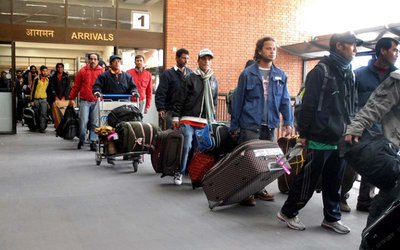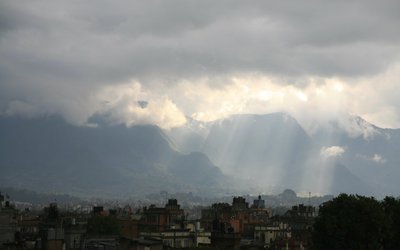The Guardian (UK) reported on 17th August that a stir is taking place in Japan. During and in the wake of the Covid-19 epidemic, as most people were staying indoors, the consumption of alcohol declined tremendously amongst young Japanese. As a result the sales and liquor tax revenues declined in the country. Because of this, the National Tax Agency of Japan is overseeing a country wide ‘Sake Viva’ campaign to make drinking more attractive and thereby boost the alcohol industry. Were the younger Japanese drinkers switching over to Asahi beer or even to Suntory, Nikka Cos and Yamazaki whiskeys? Such a campaign is perhaps necessary here, to popularise the concept of Tharra Jindabad in Nepal! Our culture entreats us to say ‘Gatte, gatte’ even when we want more! Should we not say ‘Aahaa’ as the liquid continues coming?
Varuni, the Goddess of wine was one of fourteen ‘ratnas’ to emerge after the Samudra Manthan.
The Vedas mention ‘Somras’ as an elixir for the Gods. Soma mentioned in Rig Veda states that it brings immortality and divinity to the drinkers. Soma was a term used by Aldous Huxley in his ‘Brave New World’ to depict a hallucinogen! The Somlata plant found in the Nepali Himalayas is considered to have similar properties! Aren’t we Nepalis truly blessed?
In 19th Century England of Charles Dickens we read of terrible conditions in which the poor and the working class lived. Alcohol was a means of succour and gin being a cheap source of comfort was what they turned to. They drank and depended on it and then ‘turned up their toes and died’. In adjoining rural Ireland, potatoes were the main food crop and because of its ready availability it was from this that Pucchini or the local drink was made. Starting to condense wine for smuggling from France to England and then to dilute it again was the intention of some boot-leggers. However the product proved delightful by itself and so Brandy came into being. Brandy – Cognac was claimed to be of French origin but this is disputed by Armenians who counter claim that their Cognac is much superior. In Russia too, because of the extreme cold and primitive living conditions for many in the rural areas, it was no wonder that they turned to alcohol, specifically Vodka, to keep them warm. The basic ingredients potatoes and sugar was what caused shortage during Gorbachev’s time in the 1990s. Nearer home our Northern neighbour has been making the fabled Maotai, from fermented sorghum (jowar) since last five hundred years.
In Germany they have the ‘Oktober Fest’. We can counter claim that we have the ‘Dasai Tihar Break’ when consumption of alcohol is at a peak in Nepal. The second peak is in Dec. Jan. time when we have as many as five New Years to celebrate! Yes alcohol is bad for one’s health but when taken in moderation, more as a social custom it brings about harmony in the community. The introduction and implementation of ‘Mapase’ as a criteria for alcohol consumption was very timely and must be enforced with strictness all the year around especially on long distance travel routes.
Nepali society of former times proclaimed, ‘The bahuns do not take jaand, nor do they know the taste thereof’! However the Devis in our temples are offered animals / birds sacrifices and liquor too at times of worship. Religious Brahmins then, would take a few drops of the jaand utilised for puja and sprinkle it with their fingers into their open mouths. It was the Newars who, with their traditional heritage and culture, perfected the art of homemade wine from fermented rice i.e. jaand and aila also with distilled rice. Besides these our northern regions have tongba from fermented millet plus chhyang and rakshi too. There is a tradition of flavouring some local products with other chillis, spices, paan and even yarshagumba. This last presentation is perhaps the influence of the Korean Chhaang product with the additional herb inside. The onus now is to make our Nepali local drinks more marketable.
There has been the production, distribution and consumption of locally made wines in Nepal for ages but somehow the makers have not been able to compete with the vineyard products of foreign lands such as Australia, Chile, France and Germany. Why is this?
During the last week August police arrested five persons for bottling nakkali liquor as foreign and local brands at a factory in Duwakot. Such a product would be consumed in hotels, lodges, dance bars and party palaces! The practise is to serve real stuff for one or two rounds and then switch to nakalli ones!
The licensing of locally produced and properly packaged alcoholic products will put a stop to the illegal distillation taking place in various parts of Nepal. The importation of fakes or imitations of famous international brands is said to be openly occurring even in reputed hotels! Curtailment of such activity is essential. Proper branding of locally made products will certainly prevent the type of ‘hooch deaths’ that occur from time to time in our part of the world. Like the Sake of Japan, the rakshi and jaand made from Taichin rice is our Nepali answer.
Surprisingly beers, lager or otherwise whether as offshoots of foreign brands or local brands are now freely available in Nepal. More recently Craft beers have entered the market and have been welcomed by the hotel industry. Under the surface however, it is not a level playing field as those within the inner circle are preventing the entry of newcomers by hook or by crook. Presently, with depleting foreign exchange the government is stressing on ‘Make in Nepal’. Its concern can be proved by passing the bill making branding of local alcoholic products a reality in Nepal. Such action will help the local industry and can be celebrated by saying ‘Gambe’ as we send local liquor down our gullets! Presently the government in its short-sidedness is thinking of lifting the ban on foreign alcohol import after Dasain.
As an end piece it is not only humans who get high on alcohol. Elephants, ostriches, baboons and even warthogs of South Africa eating ripe high alcohol containing ‘Marula’ fruit become inebriated and go around creating damage in the same manner that over-drunk humans do too! This is what life is all about.
The author is a retired medical doctor and writes fiction under the pen name of Mani Dixit also. Website: www.hdixit.org.np. Twitter: @manidixithd

Hemang Dixit
The author writes fiction under the name of Mani Dixit. Website: www.hdixit.org.np. Twitter: @manidixithd
- Top Heavy
- Sep 20, 2023
- Most Able?
- Sep 04, 2023
- Changing Times
- Aug 21, 2023
- Nepali Shenanigans
- Aug 03, 2023
- Budget Naataks
- Jun 29, 2023












